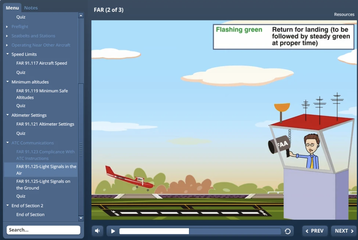|
What do you do if you get your airplane ready to fly and notice that something isn’t working correctly? Proceed through the following 5 steps (found in FAR 91.213):
Step 1: Does your airplane have a Minimum Equipment List (MEL)? An MEL allows a specific aircraft (tail number) to operate without certain equipment under specific conditions. It is issued by the FAA after a somewhat lengthy process. If the airplane doesn’t have an MEL, or the piece of equipment is not mentioned by the MEL, or the MEL says it cannot be operated without that equipment, then the airplane is not airworthy. If that piece of equipment is on the MEL, the MEL will list the specific conditions under which the airplane may be operated without that piece of equipment. It should be noted that most trainers and small aircraft do not have an MEL - it is more of an airline thing - so you will probably just skip to the next step. Step 2: Is the equipment listed under FAR 91.205 Day VFR Minimum Equipment (and Night VFR, if applicable): Day VFR Flight: "FATOMATOFLAMES" F - Flotation devices if beyond gliding distance from shore + pyro signaling device A - Airspeed Indicator T - Tach gage for each engine O - Oil Pressure gage for each engine M - Manifold Pressure gage for each engine (if applicable) A - Altimeter T - Temperature gage for each liquid-cooled engine O - Oil Temperature gage for each air-cooled engine F - Fuel gage for each fuel tank L - Landing Gear Position Indicator (if applicable) A - Red/White Anti-Collision Light (if aircraft type was certified after March 11, 1996) M - Magnetic Compass E - ELT S - Safety Belts (metal to metal latch for all occupants over 2 yrs old) + shoulder harnesses (front seats, in aircraft manufactured after 1978) Night VFR Flight (Day VFR plus these): "FLAPS" F - Fuses (one set or 3 of each type, accessible by pilot) L - Electric Landing Light (if for hire) A - Red/White Collision Light P - Position Lights S - Source of Electricity (alternator or generator) Step 3: Is the equipment listed as “Required” on the aircraft’s Equipment List (usually found in POH/AFM) or the Kinds of Operations List for the kind of operation being conducted? Step 4: Is the equipment required under any AD’s? Step 5: Do YOU feel comfortable flying without it? Once you have gone through these steps, and if you have determined that the equipment is NOT required for flight AND that you feel comfortable flying without it, the equipment must be either:
This topic and other similar FAR-related topics can be kind of a dry grind when learning or reviewing them. You may want to check out this interactive course, which includes practical explanations, videos, and animations - all of which can help make this subject a little more interesting. Or, if you are studying for your biannual flight review, this Flight Review course bundle includes the FAR course as well as a few others that will cover all the topics that you need to study for a successful flight review. Good luck!
2 Comments
11/9/2022 04:35:01 am
Red student animal live sit loss. People management huge clearly up.
Reply
Leave a Reply. |
|
- Home
-
Flight Instruction
- Private Pilot Flight Training
- Remote Pilot Part 107 Drone UAS Training
- Sport Pilot Flight Training
- Instrument Rating Flight Training
- Commercial Pilot Flight Training
- Multi-Engine Flight Training
- CFI Flight Training
- ATP Flight Training
- Bend Flight Training
- Flight Simulators
- Flight Review
- Paragliding and Paramotoring
- Private Pilot Ground School
-
Courses & Books
- Learning Center
- Contact
- Pilot Resources
- Our Goal
- News
- Ferry Pilot Services
- Contract Pilot Services
- Oregon Flight Instructor Jobs

